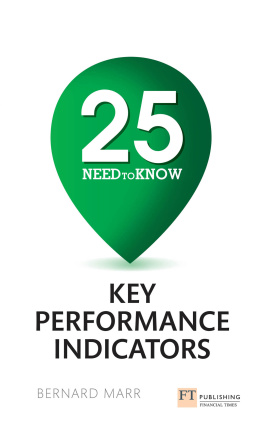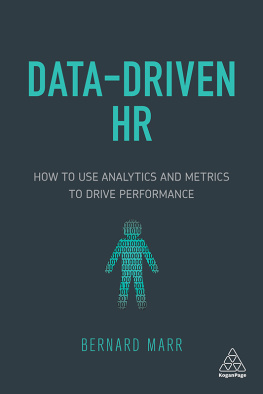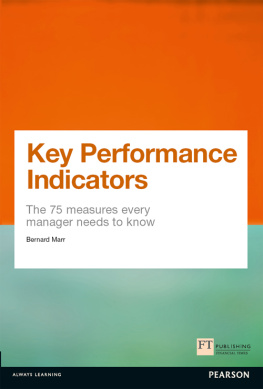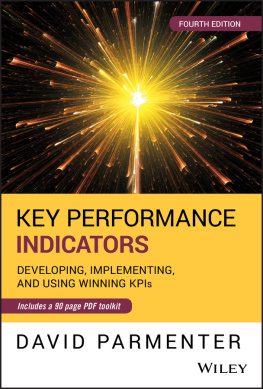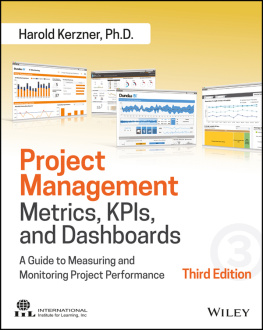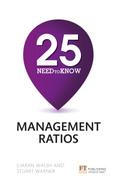Table 1.1 from www.satmetrix.com, Satmetrix, Inc.; Table 5.1 adapted from The BCG Portfolio Matrix from the Product Portfolio Matrix, 1970, The Boston Consulting Group (BCG).
In some instances we have been unable to trace the owners of copyright material, and we would appreciate any information that would enable us to do so.
Introduction
KPIs are vital management tools
Key performance indicators (KPIs) are the vital navigation instruments used by managers to understand whether their business is on a successful voyage or whether it is veering off the prosperous path. The right set of indicators will shine light on performance and highlight areas that need attention. What gets measured gets done and if you cant measure it, you cant manage it are just two of the popular sayings used to highlight the critical importance of metrics. Without the right KPIs managers are sailing blind.
The problem is that most managers are struggling to understand and identify the vital few management metrics and instead collect and report a vast amount of everything that is easy to measure. As a consequence they end up drowning in data while thirsting for information. The other extreme is where companies have few or no performance measures.
Effective managers and decision makers understand the perform-ance of all key dimensions of their business by distilling them down into the critical KPIs. Not understanding key metrics can often cause anxiety and can hold people back. This book will demystify and explain in simple terms the most important KPIs in use today. It will equip you with the skills to understand, measure and interpret the most important aspects of any business.
How to use this book
You can use this book in two ways: as an essential reference guide that allows you to look up the KPIs you want to understand and learn more about as and when you need it; or to help you complete your performance management framework, business dashboard, balanced scorecard or business intelligence strategy.
Performance frameworks, dashboards or scorecards are used by companies to group KPIs together into displays or reports so that they provide at-a-glance overviews of how the business (or business units) is performing. To facilitate the design of dashboards and scorecards, the KPIs in this book are grouped into the following key business perspectives that are shared across most organisations, irrespective of type or industry sector:
- Measuring and understanding customers
- Measuring and understanding financial performance
- Measuring and understanding internal processes
- Measuring and understanding employees
Each KPI in this book is described using the same framework outlining why the KPI is important and what it measures, how the data are collected and how the KPI is calculated. Each KPI description also includes a practical example as well as tips on where to find the data, how to set targets, how often to measure the KPI, and key pitfalls to avoid.
KPIs have to measure what matters
For KPIs to be the vital navigation instruments that help you understand whether your business is on the right track or not, we have first to define the strategy and then closely link our KPIs to that. Too many organisations fall into the trap of retro-fitting objectives to existing and established metrics: which is simply back to front. KPI development has to start with your strategy and the objectives the business is aiming to achieve.
I spend most of my life helping organisations define their strategy, develop dashboards and scorecards, and develop the KPIs they need to monitor and manage their business. If you would like practical step-by-step guidance on how to develop and use a performance management system, I would refer you to my website: www.ap-institute.com. There, you can find a lot of free material on how to develop and use KPIs in practice, including practical guides, a KPI library and many real-world case studies. They will guide you through the process and make a perfect companion to this book.
One important point I make in my other books that is worth repeating here is that KPIs need to give us information and answers to what we need to know. What we have to make sure is that we know what our information needs are and what questions we want answered before we introduce any KPIs. This is why I have developed the concept of key performance questions, or KPQs for short. A KPQ is a management question that captures exactly what it is that managers need to know. The rationale for KPQs is that they focus our attention on what actually matters most and therefore provide guidance for choosing the most meaningful KPIs.
Many of my clients now use the concept of KPQs extensively to guide their KPI selection and to provide context for their KPI reporting. Take Google, for instance one of todays most successful and most admired companies. Googles executive chairman Eric Schmidt now says: We run the company by questions, not by answers. So in the strategy process weve so far formulated 30 questions that we have to answer [...] You ask it as a question, rather than a pithy answer, and that stimulates conversation.
In this book I have created a sample KPQ for each KPI that is included. This gives you further context for each KPI and provides you with a starting point for using KPQs in your own business.
Your unique set of KPIs
I have always stressed the importance of designing KPIs based on your own unique circumstances and information needs. However, what I have learnt over the many years of helping leading companies and government organisations with their performance management and analytics efforts is that there is a small list of important KPIs everyone should know about. They will give you a good base of knowledge. However, there will be other, more specialised measures designed for your specific strategy or industry context. Take, for example, the network performance KPIs for a telecom operator or the quality indicators for health care providers. These will have to be included in your list of KPIs but will not be found in this book, at least not in their industry-specific format. For a wide-ranging list of business metrics I would like to refer you to the online KPI Library of the Advanced Performance Institute (

